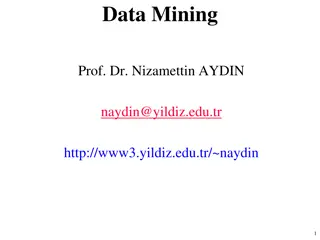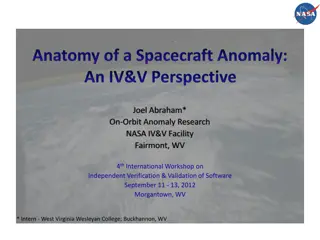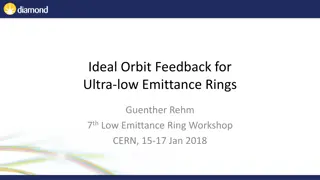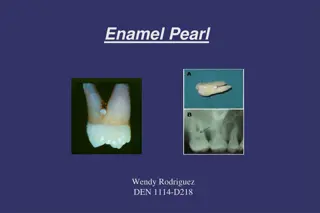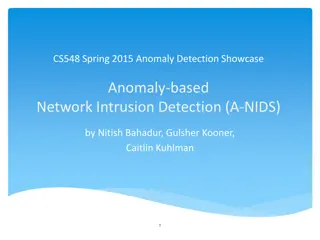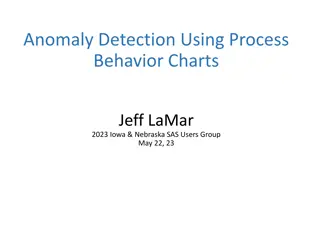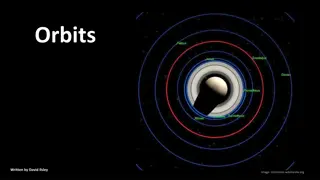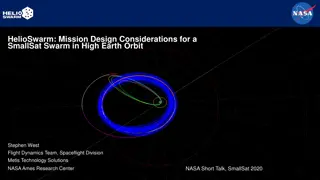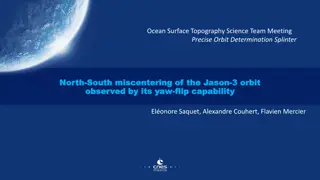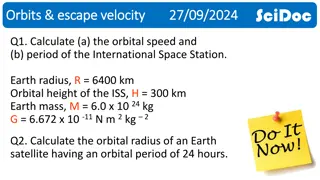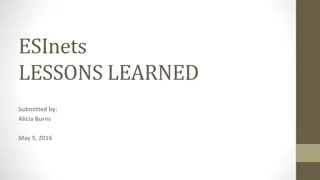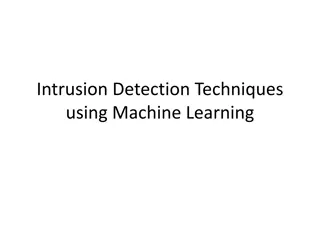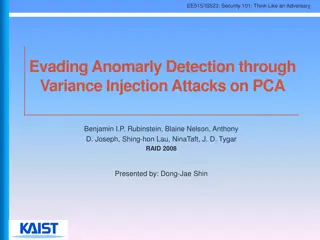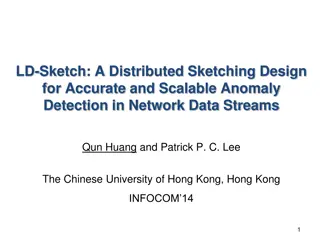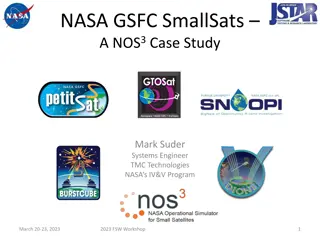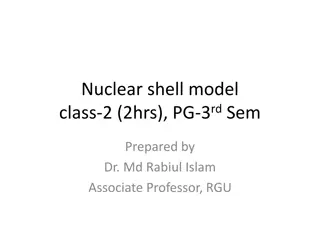Lessons Learned from On-Orbit Anomaly Research
The On-Orbit Anomaly Research workshop held at the NASA IV&V Facility in 2013 focused on studying post-launch anomalies and enhancing IV&V processes. The presentations highlighted common themes like Pseudo-Software Command Scripts, Software and Hardware Interface issues, Communication Protocols, and more. Valuable lessons and solutions were shared to improve space mission software reliability.
Download Presentation

Please find below an Image/Link to download the presentation.
The content on the website is provided AS IS for your information and personal use only. It may not be sold, licensed, or shared on other websites without obtaining consent from the author. Download presentation by click this link. If you encounter any issues during the download, it is possible that the publisher has removed the file from their server.
E N D
Presentation Transcript
Lessons Learned From On-Orbit Anomaly Research On-Orbit Anomaly Research NASA IV&V Facility Fairmont, WV, USA 2013 Annual Workshop on Independent Verification & Validation of Software Fairmont, WV, USA September 10-12, 2013
Agenda Introduction On-Orbit Anomaly Research (OOAR) Presentation Objective and Organization Anomalies Pseudo-Software Command Scripts Software and Hardware Interface Data Storage and Fragmentation Communication Protocols Sharing of Resources CPU OOAR Contact Information NASA IV&V Facility On-Orbit Anomaly Research September 10, 2013 2
Introduction On-Orbit Anomaly Research (OOAR) Primary goals: Study NASA post-launch anomalies and provide recommendations to improve IV&V processes, methods, and procedures Brief IV&V analysts on new and emerging technologies, as applied to space mission software, and on how to identify potential software issues related to them NASA IV&V Facility On-Orbit Anomaly Research September 10, 2013 3
Introduction Presentation Objective and Organization Present IV&V lessons learned from selected on- orbit anomalies Anomalies representative of some of common themes observed in post-launch software problems Five themes represented NASA IV&V Facility On-Orbit Anomaly Research September 10, 2013 4
Introduction Presentation Objective and Organization(Cont d) Five common anomaly themes represented: Pseudo-Software Command Scripts Software and Hardware Interface Data Storage and Fragmentation Communication Protocols Sharing of Resources CPU NASA IV&V Facility On-Orbit Anomaly Research September 10, 2013 5
Introduction Presentation Objective and Organization (Cont d) Topics covered: Anomaly Description Background Information Cause of Anomaly Project s Solution Observations IV&V Lessons NASA IV&V Facility On-Orbit Anomaly Research September 10, 2013 6
Anomaly: Pseudo-Software Command Scripts Anomaly Description Measurement device on science instrument disabled at start of blackout period Command to re-enable device at end of blackout period failed Failure leading to loss of science data NASA IV&V Facility On-Orbit Anomaly Research September 10, 2013 7
Anomaly: Pseudo-Software Command Scripts Background Information Two measurement devices 1 and 2 on science instrument Only one device active at any given time Blackout period imposed on active device to protect against damage from environment Active device commanded by ground software to be disabled at start of blackout period Active device commanded by ground software to be re-enabled at end of blackout period NASA IV&V Facility On-Orbit Anomaly Research September 10, 2013 8
Anomaly: Pseudo-Software Command Scripts Background Information (Cont d) Disable and enable commands part of a command script Flaw in command script: Commands labeled for device 1 only FSW fault management feature A: Process disable command for any active device even if command labeled incorrectly To protect active device during blackout period NASA IV&V Facility On-Orbit Anomaly Research September 10, 2013 9
Anomaly: Pseudo-Software Command Scripts Background Information (Cont d) FSW fault management feature B: Do not process re-enable command if mislabeled for inactive device To protect against occurrence of lower-level software error: o Not possible to re-enable an inactive device NASA IV&V Facility On-Orbit Anomaly Research September 10, 2013 10
Anomaly: Pseudo-Software Command Scripts Cause of Anomaly Device 2 active Disable command mislabeled for (inactive) device 1 FSW disabled device 2 anyway Re-enable command also mislabeled for (inactive) device 1 FSW rejected re-enable command Active device 2 staying disabled; no science data collected NASA IV&V Facility On-Orbit Anomaly Research September 10, 2013 11
Anomaly: Pseudo-Software Command Scripts Project s Solution Manually commanded (active) device 2 to be re- enabled and resume operations NASA IV&V Facility On-Orbit Anomaly Research September 10, 2013 12
Anomaly: Pseudo-Software Command Scripts Observations Anomaly due to flaw in command script used by ground software FSW not at fault FSW fault management averted a more-serious anomaly by processing mislabeled disable command: Active device 2 could have been damaged if not disabled NASA IV&V Facility On-Orbit Anomaly Research September 10, 2013 13
Anomaly: Pseudo-Software Command Scripts Observations(Cont d) FSW fault management could not stop anomaly at end of blackout period Instead, designed to protect against another software error Ground software or mission operators in better position to have caught the flaw in command script. However, no ground software fault management provision mission operators not alert enough NASA IV&V Facility On-Orbit Anomaly Research September 10, 2013 14
Anomaly: Pseudo-Software Command Scripts IV&V Lessons 1. If ground software in scope for IV&V analysis, insist on ground software to detect and protect against faults in pseudo-software, e.g., command scripts IV&V not usually around for software operation Mission operators not reliable enough due to various factors (training, alertness, performance consistency, etc.) NASA IV&V Facility On-Orbit Anomaly Research September 10, 2013 15
Anomaly: Pseudo-Software Command Scripts IV&V Lessons (Cont d) 2. If ground software out of scope for IV&V analysis, identify and report potential sources of error in ground software interfacing with FSW Result of interface analysis of FSW Caveats: Not rigorous conventional IV&V issues IV&V not able to track issues to resolution (not around for software operation) New concept in IV&V NASA IV&V Facility On-Orbit Anomaly Research September 10, 2013 16
Anomaly: Software and Hardware Interface Anomaly Description Antenna on spacecraft commanded to re-orient by rotating in delta-angle increments Fault protection maximum limit for delta-angle tripped Antenna rotation suspended in mid-maneuver NASA IV&V Facility On-Orbit Anomaly Research September 10, 2013 17
Anomaly: Software and Hardware Interface Background Information Antenna on spacecraft re-oriented through nominal 14-deg. increments of rotation FSW capable of commanding increments of rotation larger than 14 deg. Fault protection imposing limit of 14-deg. increments on FSW for mechanical stability NASA IV&V Facility On-Orbit Anomaly Research September 10, 2013 18
Anomaly: Software and Hardware Interface Background Information (Cont d) FSW counter keeping track of 14-deg. increments Electro-mechanical switch sending signal to increment or decrement counter: Increment by 1 for forward rotation signal Decrement by 1 for backward rotation signal Switch sending signal at end of 14-deg. rotations when forward or backward contact made NASA IV&V Facility On-Orbit Anomaly Research September 10, 2013 19
Anomaly: Software and Hardware Interface Cause of Anomaly Antenna structure wiggled at end of one 14-deg. rotation after coming to a halt Back and forth motion due to structure s elasticity and its momentum exchange with attached linkage Switch correctly sent forward signal first, incrementing FSW counter by 1 Switch incorrectly sent backward signal next, decrementing FSW counter by 1 NASA IV&V Facility On-Orbit Anomaly Research September 10, 2013 20
Anomaly: Software and Hardware Interface Cause of Anomaly (Cont d) Net effect: No change in counter s value at end of 14-deg. rotation FSW, monitoring counter, assuming latest command to rotate by 14 deg. having failed FSW compensating by commanding a 28-deg. rotation next time Fault protection max. limit of 14-deg. rotation tripped Antenna rotation maneuver suspended NASA IV&V Facility On-Orbit Anomaly Research September 10, 2013 21
Anomaly: Software and Hardware Interface Project s Solution Remove max. limit of 14-deg. rotations from fault protection NASA IV&V Facility On-Orbit Anomaly Research September 10, 2013 22
Anomaly: Software and Hardware Interface Observations Removing fault protection inhibit of 14-deg.: Not addressing root cause of anomaly Removing a legitimate fault protection feature and making antenna vulnerable to other faults Phenomenon causing anomaly well understood and known as switch bounce Possible solutions to switch bounce: Take multiple samples of contact state Introduce time delay in taking switch output NASA IV&V Facility On-Orbit Anomaly Research September 10, 2013 23
Anomaly: Software and Hardware Interface IV&V Lessons 1. Have a deep understanding of characteristics of hardware interfacing with software 2. Apply this understanding to software analysis of requirements, design, and tests NASA IV&V Facility On-Orbit Anomaly Research September 10, 2013 24
Anomaly: Data Storage and Fragmentation Anomaly Description Write operations to store data on a spacecraft s data storage device failed Multiple buffers filled up Fault protection limits tripped NASA IV&V Facility On-Orbit Anomaly Research September 10, 2013 25
Anomaly: Data Storage and Fragmentation Background Information Data storage and deletion lead to inevitable fragmentation of unused memory on data storage devices Level of fragmentation worsens with increasing number of write and delete operations memory space on the device filling up Problem exacerbated by inherent limits on the minimum size of data unit allowed to be stored Renders some of the smaller-size unused fragmented memory unusable NASA IV&V Facility On-Orbit Anomaly Research September 10, 2013 26
Anomaly: Data Storage and Fragmentation Background Information (Cont d) Operating System typically issuing write and delete commands Storage device s controller performing write and delete operations Operating System only aware of the overall amount of memory used, but not fragmented or unusable memory space NASA IV&V Facility On-Orbit Anomaly Research September 10, 2013 27
Anomaly: Data Storage and Fragmentation Cause of Anomaly 87% of memory capacity of Solid-State Recorder (SSR) used prior to anomaly Operating System compared size of a data file to be stored against free memory in remaining 13% of memory capacity of SSR Data file size smaller than free space on SSR Operating System issued a write command to SSR NASA IV&V Facility On-Orbit Anomaly Research September 10, 2013 28
Anomaly: Data Storage and Fragmentation Cause of Anomaly (Cont d) SSR s controller scanned entire memory space on SSR and could not find large enough free fragmented memory to store requested data in Write command failed Some of subsequent commands to write other data also failed due to shortage of usable fragmented memory space In each case, SSR s controller scanned memory space for each write request NASA IV&V Facility On-Orbit Anomaly Research September 10, 2013 29
Anomaly: Data Storage and Fragmentation Cause of Anomaly (Cont d) Excessive time taken to repeatedly scan memory space for free memory made data waiting to be written back up in buffers NASA IV&V Facility On-Orbit Anomaly Research September 10, 2013 30
Anomaly: Data Storage and Fragmentation Project s Solution Through flight rules, SSR not allowed to get more than 90% full NASA IV&V Facility On-Orbit Anomaly Research September 10, 2013 31
Anomaly: Data Storage and Fragmentation Observations Adverse effects of data fragmentation in space missions: Loss of full capacity of data storage device Further loss of storage capacity with increasing number of write and delete operations Loss of data due to write operation failures Latency issues in data handling Other potentially more-serious problems affecting spacecraft s health and safety NASA IV&V Facility On-Orbit Anomaly Research September 10, 2013 32
Anomaly: Data Storage and Fragmentation Observations(Cont d) Data storage at a premium in space missions Currently, no practical solution to avoiding loss of full capacity of data storage Practical solution to limiting or impeding further fragmentation of free space: Set an upper limit on level of memory to be utilized on data storage device Upper-limit memory solution adopted by project in response to anomaly NASA IV&V Facility On-Orbit Anomaly Research September 10, 2013 33
Anomaly: Data Storage and Fragmentation Observations(Cont d) Project s solution relying on flight rules Disadvantages of enforcing upper memory limit through flight rules Limit enforcement not precise Requires continuous vigilance by mission operators in monitoring the memory usage level Limit enforcement not reliable Depends on alertness, training, and consistency of flight operators Flight rules not subjected to IV&V IV&V not usually engaged during software operation NASA IV&V Facility On-Orbit Anomaly Research September 10, 2013 34
Anomaly: Data Storage and Fragmentation Observations(Cont d) Advantages of enforcing upper memory limit through software Limit monitoring and enforcement more precise and reliable Software development receiving IV&V analysis NASA IV&V Facility On-Orbit Anomaly Research September 10, 2013 35
Anomaly: Data Storage and Fragmentation IV&V Lessons 1. Inevitability of data fragmentation 2. Need to contain and manage data fragmentation by enforcing upper memory usage limit below full capacity of storage device 3. Verify effectiveness of enforcing memory usage limit through software stress tests under realistic operational conditions: Accumulated number of write and delete operations undergone prior to start of test Size of data involved in write/delete operations NASA IV&V Facility On-Orbit Anomaly Research September 10, 2013 36
Anomaly: Communication Protocols Anomaly Description Downlink of a spacecraft s housekeeping and science data resulted in generation of multiple error messages by FSW on several occasions NASA IV&V Facility On-Orbit Anomaly Research September 10, 2013 37
Anomaly: Communication Protocols Background Information Downlink of data utilized CFDP (CCSDS File Delivery Protocol), requiring handshake between spacecraft and ground Ground requesting downlink of a data file Upon receipt of data, ground sending an acknowledgement message to spacecraft Upon receipt of ground acknowledgement message, spacecraft marking downlinked data for deletion when its memory space needed spacecraft sending acknowledgement message to ground NASA IV&V Facility On-Orbit Anomaly Research September 10, 2013 38
Anomaly: Communication Protocols Background Information (Cont d) Downlink transaction considered complete upon receipt of spacecraft acknowledgement message by ground Off-nominal case: Ground not receiving a final spacecraft acknowledgement message Ground re-sending own initial acknowledgement message to elicit spacecraft s final acknowledgement message o Re-sending message up to four times at regular intervals NASA IV&V Facility On-Orbit Anomaly Research September 10, 2013 39
Anomaly: Communication Protocols Background Information (Cont d) If still no response from spacecraft, o declare initial downlink a failure o repeat downlink request all over Caveat: Lack of response from spacecraft not necessarily indicative of data downlink failure NASA IV&V Facility On-Orbit Anomaly Research September 10, 2013 40
Anomaly: Communication Protocols Cause of Anomaly Ground requested downlink of data Data downlinked Ground acknowledged downlink Spacecraft received ground s acknowledgement Spacecraft marked downlinked file for deletion No acknowledgement received from spacecraft after repeated re-sending of ground s initial acknowledgement NASA IV&V Facility On-Orbit Anomaly Research September 10, 2013 41
Anomaly: Communication Protocols Cause of Anomaly (Cont d) Ground declared downlink a failure Ground re-initiated downlink request Data file requested for downlink already deleted on board spacecraft Error message issued by FSW for ground requesting downlink of a missing date file NASA IV&V Facility On-Orbit Anomaly Research September 10, 2013 42
Anomaly: Communication Protocols Project s Solution Despite handshake fault, initial downlink found to be successful Downlinked data recovered from ground system For future downlinks, interval between re-sending ground s acknowledgement (in response to off- nominal case) shortened In turn shortening time between initial and second downlink requests in off-nominal case Reducing likelihood of requested downlinked file having been deleted NASA IV&V Facility On-Orbit Anomaly Research September 10, 2013 43
Anomaly: Communication Protocols Observations Root cause of anomaly, i.e., reason for failure of receiving final acknowledgement from spacecraft, neither identified nor addressed in solution by project Many components in various segments and elements playing a role in downlink process Spacecraft and Ground segments Software and Hardware elements Human operators in MOC s, SOC s, ground stations NASA IV&V Facility On-Orbit Anomaly Research September 10, 2013 44
Anomaly: Communication Protocols Observations(Cont d) Multiple sources of potential errors may lead to downlink anomalies NASA IV&V Facility On-Orbit Anomaly Research September 10, 2013 45
Anomaly: Communication Protocols IV&V Lessons 1. Recognition of need for explicit elaborate requirements addressing every aspect of nominal and off-nominal data downlink Reference by project to downlink protocol standards as substitute to customized requirements not acceptable Standards may be incomplete and evolving Standards may not address peculiarities of a given mission NASA IV&V Facility On-Orbit Anomaly Research September 10, 2013 46
Anomaly: Communication Protocols IV&V Lessons (Cont d) 2. Expecting comprehensive set of tests to thoroughly verify data downlink requirements Burden on test scenarios to compensate for incomplete or missing requirements addressing both nominal and off-nominal conditions Injecting errors originating from numerous components of downlink process in tests NASA IV&V Facility On-Orbit Anomaly Research September 10, 2013 47
Anomaly: Sharing Resources CPU Anomaly Description Command processing failed on a number of occasions on board a spacecraft in software processing instruments data NASA IV&V Facility On-Orbit Anomaly Research September 10, 2013 48
Anomaly: Sharing Resources CPU Background Information Command processing and data compression both performed on the same computing processor Data compression a particularly computation- intensive operation Command processing, especially driven by a command script with a heavy load of commanding activities, also intensive in computing NASA IV&V Facility On-Orbit Anomaly Research September 10, 2013 49
Anomaly: Sharing Resources CPU Cause of Anomaly Command processing failed while running simultaneously with data compression Both tasks sharing same CPU resources Data compression CPU-intensive Data compression given higher priority for CPU resources by FSW NASA IV&V Facility On-Orbit Anomaly Research September 10, 2013 50


